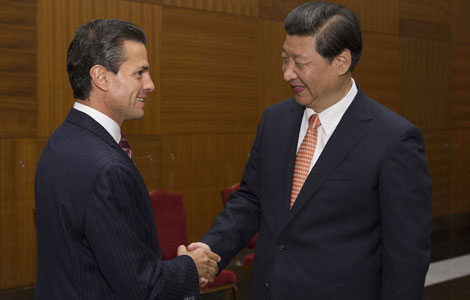It's a girl! DC panda cub thrives
Updated: 2013-09-06 12:10
By Chen Weihua in Washington (China Daily)
|
||||||||
|
Visitors watch Tian Tian play in the yard of the Giant Panda Habitat at the Smithsonian's National Zoo on Thursday morning. The zoo announced the cub born on Aug 23 is a girl and Tian Tian is her father. Chen Weihua / China Daily |
On a sunny Thursday morning, Tian Tian, the male panda who just turned 16 on Aug 27, sat on the grass at the Smithsonian's National Zoo facing the throngs of visitors. He seemed to be deep in thought. Eventually he moved his 264-pound bulk into a nearby pond of water, still pondering.
What he didn't know was that just moments earlier, the zoo had announced that he was the father of both the surviving cub and another stillborn female cub delivered a week and a half ago.
The zoo confirmed on Thursday that the giant panda cub born there on Aug 23 was a female and was in good health.
A paternity examination showed that Tian Tian is the cub's father, while the second stillborn cub that Mei Xiang delivered on Aug 24 was also a female, and also sired by Tian Tian. The cubs were fraternal twins. (Mei Xiang had been artificially inseminated with semen from both Tian Tian and a second male giant panda, Gao Gao, in the San Diego Zoo.)
Zoo scientists used two tests to confirm the sex of the cubs. The first test was developed by scientists in China and analyzes a fragment of the zinc finger protein gene. The second test, also using a shorter fragment of the same zinc finger protein gene, was developed by the Smithsonian Conservation Biology Institute (SCBI) scientists and veterinarians and was used to verify the findings of the initial test, according to the zoo.
For the paternity tests, they compared genotype profiles of DNA samples from the cubs to profiles from Mei Xiang, Tian Tian and the Gao Gao.
The SCBI had blood samples from Mei Xiang, Tian Tian and Gao Gao on hand from previous research.
They compared a small sample of muscle tissue from the stillborn cub and a tiny sample of cheek cells from the cub born Aug 23 with the adult pandas' DNA samples for the test. Veterinarians obtained the cheek cell sample with a swab during a preliminary health check Aug 25, according to the zoo.
"The genetics laboratory conducts conservation research services for the zoo and the entire Smithsonian, including sexing animals, determining paternity, and disease testing," said Rob Fleischer, head of the SCBI's Center for Conservation and Evolutionary Genetics.
"This was a great opportunity to assist our reproductive and panda biologist colleagues to assess their artificial insemination methods in pandas," he said.

 China, Russia a step closer on gas supply
China, Russia a step closer on gas supply
 18-year-old panda conceives triplets
18-year-old panda conceives triplets
 Testing times for G20 leaders
Testing times for G20 leaders Homemade choppers make aerobatic stunt debut
Homemade choppers make aerobatic stunt debut
 World-class partners bring NBA global games to Chinese fans
World-class partners bring NBA global games to Chinese fans
 Shanghai's visa-free policy lifts tourism
Shanghai's visa-free policy lifts tourism
 Panda twin cub born at Atlanta Zoo
Panda twin cub born at Atlanta Zoo
 Xi, Mexican president meet for third time
Xi, Mexican president meet for third time
Most Viewed
Editor's Picks

|

|

|

|

|

|
Today's Top News
Beijing's new product briefing a first for Apple
China, Russia a step closer on gas supply
Brazil asks for apology from US on spying
Japan to test wall for leaking water
Low-budget education abroad for working-class
Shanghai's visa-free policy lifts tourism
Films aim for success abroad
Xi vows economic reform at G20 summit
US Weekly

|

|






